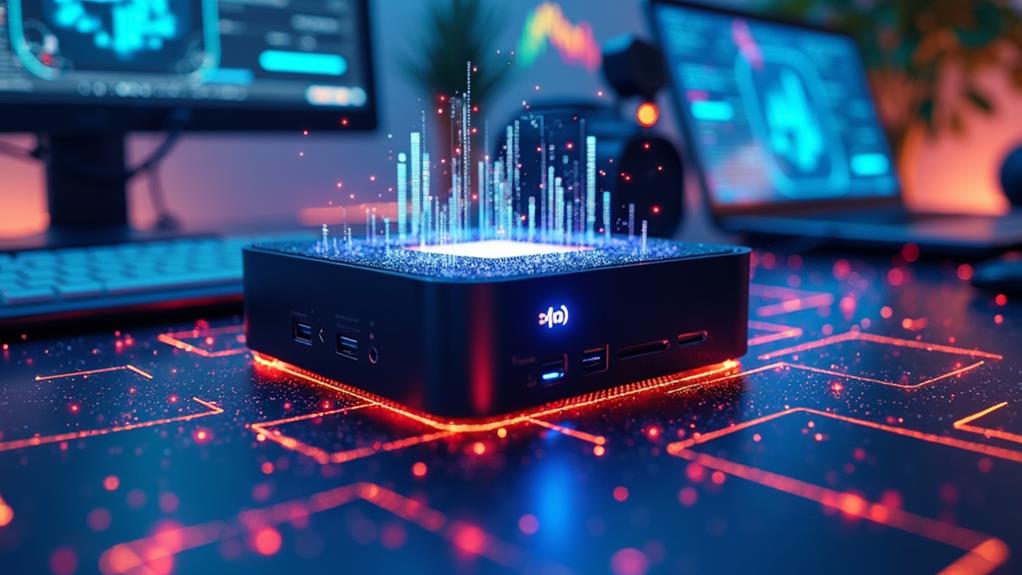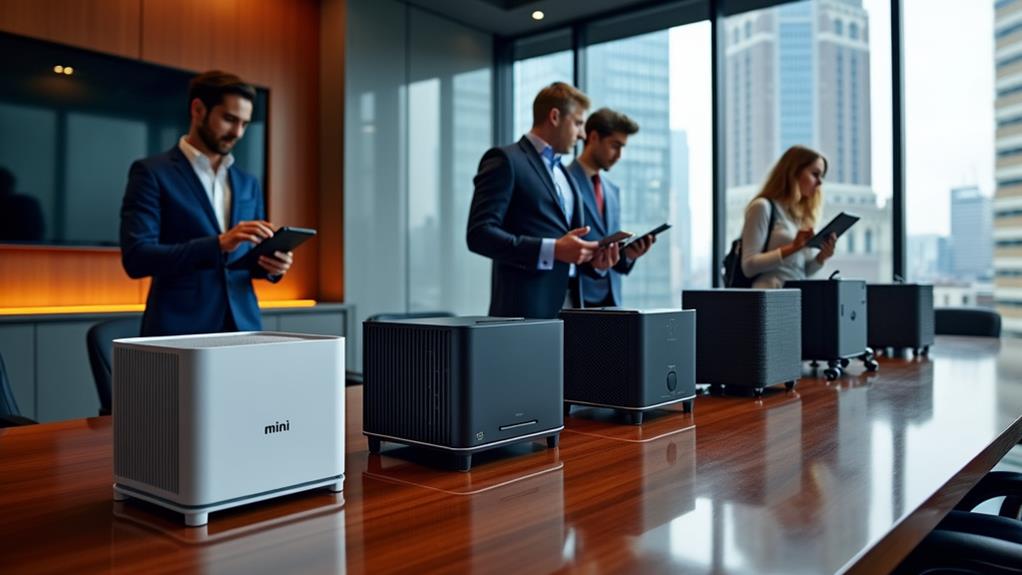



While exploring the possibility of cryptocurrency mining, you might wonder if using a cluster of mini PCs could be a viable option. These compact devices can be attractive due to their affordability and energy efficiency. However, before you immerse yourself in such a venture, it is crucial to grasp the limitations of mini PCs and whether they can sustainably handle the demands of mining various cryptocurrencies. Can you really turn a profit with mini PCs, or are they merely a curiosity for enthusiasts?
Key Takeaways
- Mini PCs lack sufficient processing power for cryptocurrency mining due to low-power CPUs and limited GPU performance.
- Their low power consumption, restricted RAM and storage, and compact design make them less suitable for intensive mining tasks.
- The profitability of mining using a mini PC depends on balancing hardware costs and electricity expenses, which can be challenging.
- Specialized hardware like GPUs or ASICs are often necessary for profitable mining operations, which mini PCs cannot provide.
- Mini PCs can be useful for testing or very low-scale mining but are generally not ideal for serious mining due to inefficient performance.
Mini PC Hardware Capabilities
Can Mini PCS Be Used for Cryptocurrency Mining?
Mini PC Hardware Capabilities
Typically, mini PCs fall short with respect to their processing power, making them less suitable for cryptocurrency mining due to the insufficient capabilities of their low-power Intel processors and limited CPU and GPU performance. This limitation is a major obstacle for mining because it requires significant computational power to solve complex algorithms. Mini PCs are equipped with processors like Intel Celeron, Pentium, or Core i3/i5/i7 CPUs, which are designed for basic tasks and lack the power and efficiency needed for intensive mining.
Additionally, these systems usually come with limited RAM (2GB to 8GB) and storage (32GB to 256GB), which are insufficient for handling the large data sets required in mining processes. In addition, mini PCs are designed to consume low power (10-30 watts) and generate minimal heat, which is contradictory to the heat and power consumption inherent in mining. They are instead designed for tasks like streaming, office work, and web browsing where computational power is not a primary concern. Consequently, due to their technical limitations, mini PCs are not well-suited for cryptocurrency mining.
Mining Requirements and Limitations
Your systems and their energy consumption should be carefully monitored due to the intensive power requirements of cryptocurrency mining, emphasizing the need for hardware designed for high-performance and reliable heat management. Mini PCs, despite their compact design, are not ideal for this process. These devices have limited CPU and GPU performance, leading to inefficient processing and insufficient power for compute-intensive tasks like mining.
Additionally, mini PCs generate less heat due to their low-power components, which is problematic for the energy-demanding and heat-generating process of mining. While they can be used for less resource-intensive activities like staking, they generally are not recommended for profitable mining operations due to their hardware constraints.
For cryptocurrency mining, specialized hardware like GPUs or ASICs are necessary to achieve the high hash rates needed to solve complex algorithms. The electricity consumption and heat generation of mini PCs make them a poor choice for mining, as the costs are likely to outweigh any potential rewards earned through the mining process. As such, it is important to evaluate the technical requirements of mining software and the efficiency of various hardware options before investing in a system for cryptocurrency mining.
Cryptocurrencies for Home Mining
Mini PCs are not designed for high-performance applications like cryptocurrency mining; instead, specialized cryptocurrencies can be mined from home computers using specific hardware options. If you're interested in home mining, you'll want to focus on cryptocurrencies that can be mined using CPU or GPU mining, rather than ASIC mining.
Cryptocurrencies like Dogecoin (DOGE) can be mined using CPU mining, but GPU mining is faster. Ethereum Classic (ETC) can be mined on desktop machines as well as ASIC machines, giving you options. Monero (XMR) is designed to resist ASIC development, making it a good choice for home mining. ZCash (ZEC) employs the Equihash algorithm, which is ASIC-resistant and requires graphics card drivers for mining. Ravencoin (RVN) is another option for home mining.
When choosing a cryptocurrency to mine, consider the market cap and daily volume. Dogecoin has a market cap of $21.8B and average daily volume of 2.5B+, while Ethereum Classic has a market cap of $4.35B and average daily volume of 300M. Monero and ZCash have smaller market caps and daily volumes, but are still viable options. By selecting the right cryptocurrency and hardware, you can successfully mine from home.
Profitability Considerations
To make cryptocurrency mining profitable, you must cautiously balance hardware costs with electricity expenses, as the wrong combination can lead to financial losses, especially during bear markets. CPU mining, for instance, can be slow and may not generate sufficient revenue to cover electricity costs. On the other hand, GPU mining with high-end NVIDIA GPUs like the RTX 3090 or RTX 3080 provides considerably higher hash rates, but the GPUs themselves can be expensive, ranging from $600 to $2000+.
Ethereum mining is often the most lucrative per watt, with AMD RX 580 or 5700 XT GPUs recommended. However, electricity costs are a major challenge for profitability, potentially outweighing the value of mined coins. Large-scale mining operations have advantages in terms of scale and access to the latest, most efficient hardware, making it difficult for at-home miners to compete. As you consider using mini PCs for crypto mining, it is crucial to factor in these profitability considerations to guarantee you're not operating at a loss. By carefully selecting the right hardware and managing electricity costs, you can increase your chances of success in the world of crypto mining.
Scaling and Heat Management
Proper heat management strategies are key to viable cryptocurrency mining, especially when scaling up operations in a home environment where efficient cooling solutions can drastically impact profitability. As you add more rigs, the heat generation substantially increases, necessitating the need for adequate cooling measures. For instance, rigs using 1000 watts act as 1000-watt space heaters, making cooling pivotal to maintain a stable operation. This challenge in scaling up is a major hurdle that at-home miners face compared to large-scale mining operations.
To combat the heat management challenges, it is vital to prioritize space planning and implement adequate cooling solutions. This involves carefully configuring the mining rigs to maximize airflow and minimize heat buildup. Energy efficiency should also be a key consideration, as reducing power consumption can help mitigate heat generation. By addressing these scaling challenges effectively, you can maintain profitability and guarantee a successful home mining setup.
Frequently Asked Questions
Can You Mine Crypto With a Mini Pc?
"Yes, you can mine crypto with a mini PC, but be aware that mini PCs have limited processing power and cooling capabilities, leading to lower mining performance and profitability compared to dedicated hardware."
What Kind of PC Do I Need for Crypto Mining?
"For crypto mining, you need hardware with high processing power, such as dedicated GPUs or ASICs, optimized for energy efficiency, and robust cooling solutions to maximize profitability in solo or pool mining strategies."
Can I Use My Home PC to Mine Crypto?
"For home mining, you need specific hardware and software, like NVIDIA GPUs for efficiency. Online guides support setting up a desktop crypto wallet for either GPU or CPU mining, and choosing between cloud services and customized rigs. Learn about energy-efficient tools, monitoring software, and mining pool creation.
What Is the Easiest Crypto to Mine on a Computer?
For effective mining strategies, consider cryptocurrencies like Monero (XMR), Ravencoin (RVN), and Dogecoin (DOGE), which are suitable for home PC mining with ideal hardware, balancing profitability with power consumption.
Conclusion
Using your mini PC to mine cryptocurrencies is like trying to fit a square peg into a round hole. It just doesn't quite work. The hardware limitations combined with the high power requirements create a setup that's unsustainable for serious mining. The financial risks and potential for hardware damage make it questionable, so it's best to ponder dedicated mining rigs for a more efficient and stable mining experience.
Disclosure: As an Amazon Associate, I earn from qualifying purchases.



